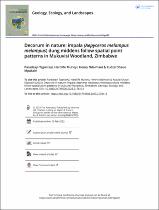| dc.contributor.author | Tagwireyi, Paradzayi | |
| dc.contributor.author | Muhoyi, Hardlife | |
| dc.contributor.author | Mpakairi, Kudzai Shaun | |
| dc.date.accessioned | 2023-02-28T09:19:57Z | |
| dc.date.available | 2023-02-28T09:19:57Z | |
| dc.date.issued | 2023 | |
| dc.identifier.citation | Tagwireyi, P. et al. (2023). Decorum in nature: Impala (Aepyceros melampus melampus) dung middens follow spatial point patterns in Mukuvisi Woodland, Zimbabwe. Geology, Ecology, and Landscapes, 6(4), 1-8. https://doi.org/10.1080/24749508.2023.2178113 | en_US |
| dc.identifier.issn | 2474-9508 | |
| dc.identifier.uri | https://doi.org/10.1080/24749508.2023.2178113 | |
| dc.identifier.uri | http://hdl.handle.net/10566/8470 | |
| dc.description.abstract | Guided by the Optimum Foraging Theory,the Avoidance Concept, and assuming that the impala Aepyceros melampus melampus defecate purposevely at dung middens, we hypothe-sized that the impala’s dung midden locations do not: (1) follow complete spatial randomness; (2) cluster along park tracks; and (3) cluster along the waterways. Using geolocation data for all impala dung middens in the Mukuvisi Woodland, Zmbabwe, the G(r) function revealed a clustered pattern at 0–100 m. Additionally, the 2nd Order Gcross function showed evidence of spatial aggregation of dung middens to within 25 m of park tracks, but no evidence of spatial aggregation between impala dung middens and waterways. Our findings give insight into possible evolutionary decorum for optimum olfaction, energy-saving, disease,pest avoidance, and contamination avoidance. | en_US |
| dc.language.iso | en | en_US |
| dc.publisher | Taylor and Francis Group | en_US |
| dc.subject | Mamals | en_US |
| dc.subject | Climate change | en_US |
| dc.subject | Conservation | en_US |
| dc.subject | Wildlife | en_US |
| dc.subject | Zimbabwe | |
| dc.title | Decorum in nature: Impala (Aepyceros melampus melampus) dung middens follow spatial point patterns in Mukuvisi Woodland, Zimbabwe | en_US |
| dc.type | Article | en_US |

